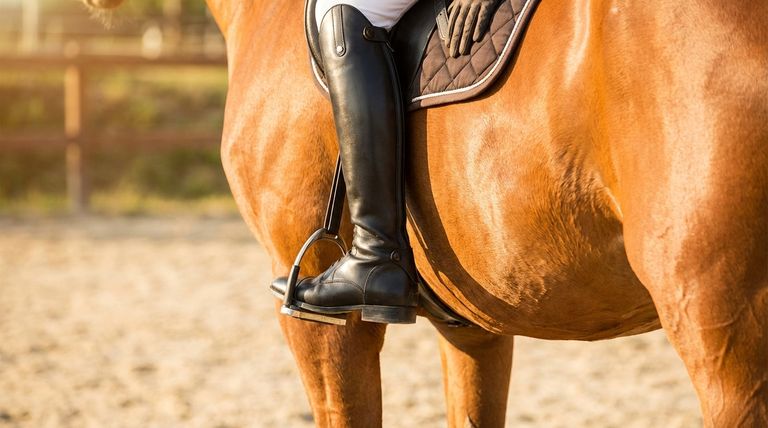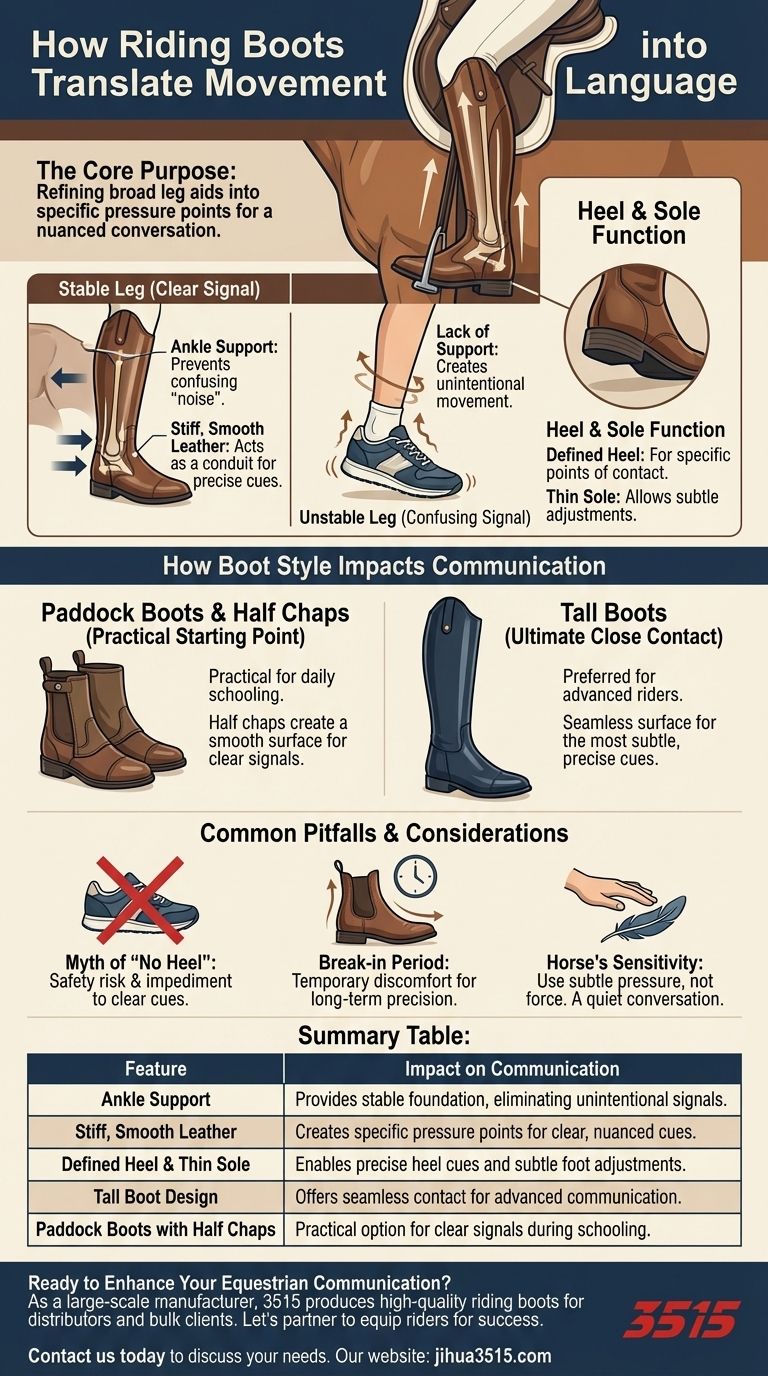Fundamentally, riding boots are a primary interface for communication between horse and rider. More than just safety equipment, their specific design translates the rider's leg and heel movements into clear, precise signals. This allows for a subtle dialogue that guides everything from speed and direction to complex maneuvers.
The core purpose of a riding boot, beyond safety, is to refine a rider's broad leg aids into specific pressure points. This transforms a potentially blunt signal into a nuanced and effective conversation with the horse.

How Boots Translate Movement into Language
A rider's leg is the main tool for asking a horse to move forward, sideways, or change its gait. The boot is what focuses the intent of those movements into a signal the horse can easily understand.
The Foundation of a Stable Leg
A proper riding boot provides significant ankle support. This stability is critical because it prevents the lower leg from wiggling or bouncing, which would create confusing, unintentional "noise" for the horse. A stable leg is the foundation of clear communication.
Creating Specific Pressure Points
The relatively stiff, smooth leather of a riding boot acts as a conduit. Unlike a soft sneaker that would distribute pressure broadly, a boot allows the rider to apply a specific cue with the calf, ankle, or heel. This distinction is the difference between a vague suggestion and a clear request.
The Function of the Heel and Sole
While the distinct heel of a riding boot is a crucial safety feature to prevent the foot from slipping through the stirrup, it also serves as a precise communication tool. It allows for a very specific point of contact when a stronger cue is needed. The smooth, thin sole allows for subtle adjustments of the foot's position in the stirrup without friction or getting stuck.
How Boot Style Impacts Communication
Not all riding boots offer the same level of communicative finesse. The primary distinction is between short paddock boots and tall boots, each designed for different contexts.
Paddock Boots: The Practical Starting Point
Paddock boots are ankle-high and are the standard for daily schooling, lessons, and younger riders. They are practical and less expensive, but for clear communication, they almost always require the use of half chaps—leather coverings that go from the ankle to the knee. The half chap creates the smooth, continuous surface needed for the leg to give clear signals.
Tall Boots: The Standard for Close Contact
Tall boots, which extend to just below the knee, are the preferred choice for serious competitors and advanced riders. Their design creates one seamless surface along the rider's entire lower leg. This provides the ultimate "close contact" feel, eliminating any interference and allowing for the most subtle and precise cues possible.
Common Pitfalls and Considerations
Choosing the right boot involves balancing function, comfort, and purpose. Understanding the inherent trade-offs is key to making an informed decision.
The Myth of "No Heel is Fine"
Using footwear without a defined heel, like sneakers or hiking boots, is a significant safety risk. It is also a major impediment to communication, as these shoes lack the structure to give clear, isolated cues and often have treads that can get dangerously stuck in the stirrup.
The Break-in Period
The stiffness that makes a boot an effective communication tool also means most new boots require a break-in period. This initial discomfort is a temporary trade-off for the stability and precision the boot will offer long-term.
Forgetting the Horse's Sensitivity
A good boot enhances communication, but it also magnifies the rider's movements. Riders must remember that the horse is highly sensitive. Clear communication relies on subtle pressure, not force. The goal is a quiet conversation, not a loud command.
Making the Right Choice for Your Goal
Your choice of boot should directly reflect your riding ambitions and context.
- If your primary focus is learning and casual riding: Paddock boots with half chaps offer the best combination of safety, functionality, and value.
- If your primary focus is competing or advanced training: Tall boots are a necessary investment for the precision and close contact required at higher levels.
- If your primary focus is simply safety and comfort around the stable: A sturdy paddock boot is a practical and protective piece of equipment for both groundwork and riding.
Ultimately, the right boot serves as a silent translator, turning your physical intent into the horse's willing action.
Summary Table:
| Feature | Impact on Communication |
|---|---|
| Ankle Support | Provides a stable leg foundation, eliminating confusing, unintentional signals. |
| Stiff, Smooth Leather | Creates specific pressure points for clear, nuanced cues instead of vague suggestions. |
| Defined Heel & Thin Sole | Enables precise heel cues and allows for subtle foot adjustments without friction. |
| Tall Boot Design | Offers seamless contact for the most subtle and advanced communication. |
| Paddock Boots with Half Chaps | A practical option that provides the necessary surface for clear signals during schooling. |
Ready to Enhance Your Equestrian Communication?
The right boot is a critical piece of equipment for any serious rider or supplier. As a large-scale manufacturer, 3515 produces a comprehensive range of high-quality riding boots for distributors, brand owners, and bulk clients. Our production capabilities encompass all types of equestrian footwear, from durable paddock boots to precision tall boots, ensuring your customers get the perfect blend of safety, comfort, and communicative clarity.
Let's partner to equip riders for success. Contact us today to discuss your specific needs and how we can bring value to your business.
Visual Guide

Related Products
- Factory-Direct Wholesale Canvas Boots with High-Traction Rubber Soles
- Safety Footwear Wholesale Manufacturer for Custom OEM/ODM Production
- Wholesale Safety Footwear Manufacturer for Bulk & Custom OEM Orders
- Customizable Anti-Smash Safety Boots for Wholesale & Private Label Manufacturing
- Factory Direct Wholesale Rain Boots Durable Waterproof & Fully Customizable
People Also Ask
- What should be avoided when storing boots with outsoles? Protect Your Investment from Dry Rot & Decay
- What types of work environments are hiker-style rubber outsoles best for? Ideal for Outdoor & Industrial Safety
- What types of rubber are typically employed in non-slip footwear soles? Your Guide to Maximum Grip and Safety
- Why is rubber commonly used for non-slip soles? The Science of Superior Grip
- What factors determine the slip resistance of rubber-soled shoes? Tread, Compound & Design Explained



















